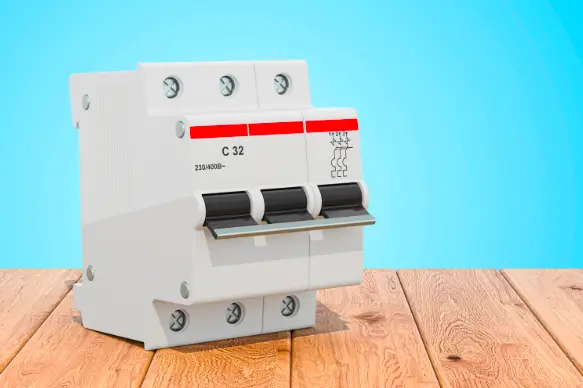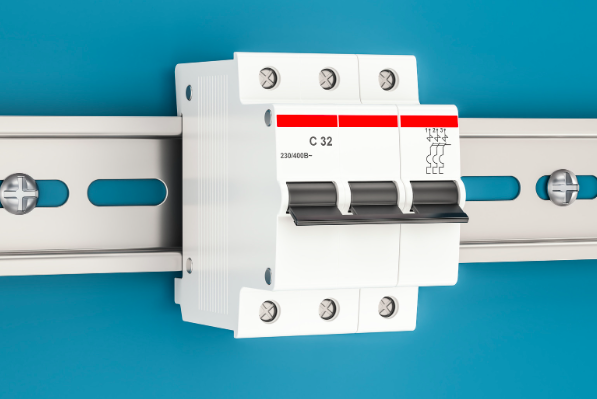Last Updated on November 25, 2022 by mdmtool
MCCB (Molded Case Circuit Breaker) and MCB (Miniature Circuit Breaker) are two circuit breakers used in electrical systems. While they both serve the same purpose of protecting circuits from overloads, there are some differences between them.
What is MCCB?

MCCB, or Molded Case Circuit Breaker, is an electrical safety device that protects circuits from excessive current.
What is MCB?

An MCB or Miniature Circuit Breaker is an electrical device that protects an electrical circuit from damage caused by overload or short circuits.
Difference Between MCB and MCCB

Purpose: The purpose of an MCB is to protect circuits against overloads and short courses, while an MCCB protects against phase loss, phase unbalance, and ground fault currents.
Voltage: MCBs are used in domestic and commercial installations where the voltages do not exceed 230/400 volts AC. MCCBs are used in industrial installations where voltages can be as high as 690 volts AC.
Current Rating: The current ratings of MCBs range from 1 ampere to 63 amperes, while the current ratings of MCCBs range from 16 amperes to 6,300 amperes.
Electrical Protection: MCBs provide electrical protection using either thermal or magnetic effects, while MCCBs provide electrical protection through thermal and magnetic products.
Pole: MCBs are available in 1, 2, 3,and 4-pole versions. MCCBs are also available in 1, 2, 3, and 4-pole versions.
Interrupting Capacity: The interrupting capacity of an MCB is typically ten kA or less, while the interrupting capacity of an MCCB can be as high as 100 kA.
Coil Voltage: MCBs are available in coil voltages of 12 volts, 24 volts, 48 volts, and 110/120 volts.
MCCBs are available in coil voltages of 240 volts, 480 volts, and 600 volts.
Types: There are two main types of MCBs: thermal-magnetic and electronic.
There are three main types of MCCBs: thermal magnetic, electronic, and hydraulic magnetic.
Trip adjustment: MCBs and MCCBs both have trip adjustment features that allow the user to adjust the trip settings of the circuit breaker. This can be useful when the circuit breaker is used in an environment with variable conditions.
Tripping Mechanism: MCBs have a bimetallic strip as the tripping mechanism; on the other hand, MCCBs have an electromagnetic coil as the tripping mechanism.

Auxiliary Contact: MCBs and MCCBs both have auxiliary contacts that can be used to connect devices such as alarms or indicators.
Current Rate: The current rate of MCBs is 100 amperes, while the current rates of MCCBs range from 10 amperes to 200 amperes.
Operation: MCBs are manually operated, while MCCBs can be either manually operated or remotely operated.
Remote Connectivity: MCBs don’t have remote connectivity features; they must be on and off. MCCBs are available with remote connectivity features.
Size: MCBs and MCCBs are available in a variety of sizes. The size of the circuit breaker will be determined by the amperage rating and the number of poles.
Maintenance: MCBs and MCCBs require regular maintenance to ensure they work properly.
Installation: MCBs and MCCBs can be installed by a qualified electrician.
Standard: IEC 60898-1 is the international standard for MCBs, while IEC 60947-2 is the global standard for MCCBs.
Cost: MCBs and MCCBs vary in price, depending on the manufacturer, model, and features. Generally, MCBs are less expensive than MCCBs.
Utility: MCBs and MCCBs play a vital role in the electrical protection of circuits. MCBs are used in domestic and commercial installations, such as homes, offices, and small businesses. While MCCBs are typically used in industrial facilities, such as factories and power plants.

FAQS
What is Interrupting Capacity?
The interrupting capacity of a circuit breaker is the maximum amount of current that the breaker can safely interrupt. This is usually expressed in terms of amperes or kA (kilowatts).
How do I Choose the Right Circuit Breaker?
These factors should be considered in choosing a circuit breaker;
- Interrupting capacity
- Voltage rating
- Current rating
- Number of poles
- Type of protection required
- Mounting style
- Size and weight
Conclusion
MCCBs and MCBs have unique features and benefits that make them suitable for different applications. It is important to consider the specific needs of your project to choose the right type of circuit breaker.





